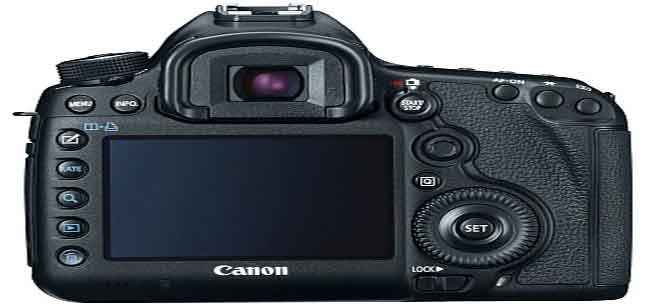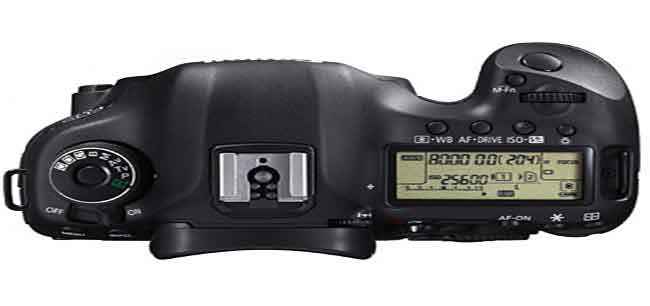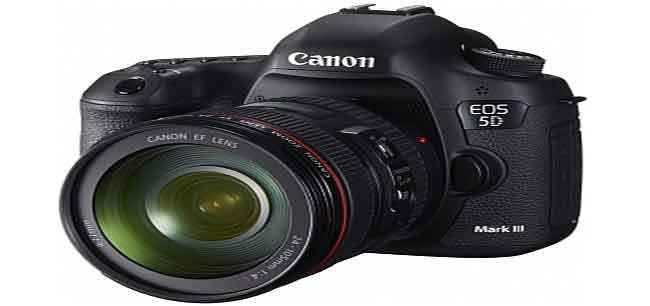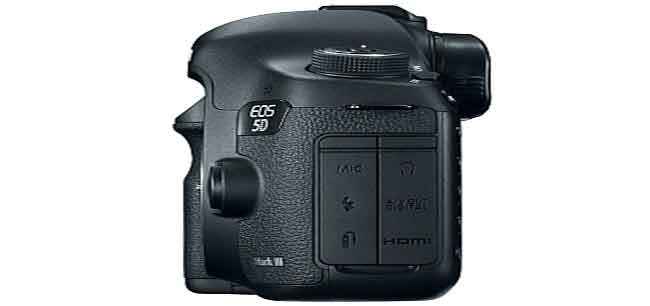That Canon EOS 5D Mark III is the celebrated successor to the wildly popular 5D Mark II, packing in several significant improvements, new technologies, but only a 22MP sensor. We know that pixel count isn't everything (and we implore that you feel the same) but Canon claims that the sensor employs a design different from its predecessor. Then there is the Digic 5+ chip for processing and a 51-point AF sensor. The combination of all this results in a camera that's got great ISO performance, stellar video quality and an AF system that tackles low light situations extremely well. However, the 5D MarkIII comes with a huge price tag of INR 206,995 so if you're wondering if the camera is worth your money, then read on.
Many things have been said and assumed about the EOS 5D Mark III, given its so called low pixel count and exuberant price point. The EOS 5D Mark II began retailing for $2699 whereas the Mark III begins retailing at $3460. That’s a difference of $800, which is quite significant, given that the pixel count didn’t see much of a rise.
However, the EOS 5D Mark III isn’t about just perfect image quality or stellar video, but also about a greater shooting experience. We managed to spend quite a bit of time with Canon’s flagship full frame DSLR and we think there is a lot going on under the hood that goes ignored. Regardless, we’ll dive right into things and give you a full run-down of what the EOS 5D Mark III can and cannot do, what works and what doesn’t, what’s great and what’s not so great.
Build and Ergonomics
.jpg) |
 |
 |
 |
 |
At first glance the Mark III doesn’t look that different from the Mark II. But upon closer inspection, you realize that the Mark III has a more curvaceous build. This is especially noticeable on the area where you’d normally find the pop-up flash. The body has an extensive weather sealing system, so shooting in light rain should be no issue whatsoever. Many criticize Canon for eliminating the pop-flash from the higher end cameras, but the move makes sense when considering weather sealing. The pop-up flash has crevices that could be potential leak points. Canon could re-enforce it with seals, but that’s just added engineering and expense.
The main attraction of the EOS 5D Mark III can be found when the camera is turned around. The back has been completely changed, so to speak, and now looks almost exactly like the 7D. As many who have played with the 7D and Mark II would agree, the 7D was far easier to shoot hand-held video with its dedicated start-stop button.
Overall, the EOS 5D Mark III feels a lot easier to use, especially for video. It is lighter too, making the whole hand-holding business a lot easier.
Features
The EOS 5D Mark III comes loaded with many features that make the EOS 5D Mark II look like a thing of the past. For starters, there is the obvious 7D resemblance with respect to the ergonomics. The DoF (Depth of Field) preview button has moved from the left to the right and changed from being a tiny circle to a pretty decent sized button.
Previously, the jog dial at the back created some problem for those recording video. Any time the dial was turned, it created noticeable clicks which would end up making their way into the audio track. Canon has rectified this by giving the job dial touch sensitive controls, so that ISO, shutter speed and aperture can be changed without the audio getting messed up.
Another feature on the EOS 5D Mark III that we absolutely love is the “silent shutter” mode. Now this mode has been around in some cameras for a while, but when we checked out the Mark III’s abilities to keep the decibels in check, we were quite shocked. We shot in several absolutely silent settings and the people around didn’t even notice they were being photographed. We had to tell them to particularly pay attention for any subtle sounds, upon which, they could detect the sound of the shutter. The mode is actually contingent on the mirror and not the actual shutter. The slap of the mirror going up before the shutter is what causes the real sound and looks like Canon has found a way to silence the mirror for the most part. This nifty ability comes at the price of the burst mode, which gets reduced from 6fps to 3fps.
Silent shutter and touch dial aside, the camera also gains in-camera HDR, multiple exposure and in-camera RAW editing capabilities. Most of these, especially HDR and multiple exposure have been around in the Nikon system for a while, so it seems like Canon is finally catching up to the trend, but all in all, we’re pretty glad to find these features make it into the EOS 5D Mark III.
Focus
Talk to anyone who has owned the EOS 5D Mark II and they will rave about the camera, but also slip in some level of disappointment with the AF system. Personally, we never had any luck in low light, with the center point having a 50-50 chance of nailing focus. Dimly lit pubs were never a good place to shoot with the EOS 5D Mark II, unless you used manual focus for the whole thing. But when you spend so much money on a camera, you expect things to work and the AF in the EOS 5D Mark II didn’t.
After much flaming, Canon has fixed every complaint users have had with the Mark II by infusing the 1Dx’s AF system into the Mark III. We’re looking at 61 AF points with 41 cross type points. This is an insane bump, if you consider that the previous model had only 9AF points and 1 cross type AF point. The power of the 1Dx focus system has been augmented by the simplicity of the AF design of the 7D. The AF can be tweaked around to work with point expansion/contraction, zone select etc. However, the EOS 5D Mark III takes things up a notch by including 6 presets that tweak the overall AF performance based on the situation under which one is shooting. The presets are based on linear movement, erratic movement etc and basically vary the sensitivity of the tracking capabilities.
The Mark III allows the selection of number of available focus points between 61 (all AF points), cross-type only, 15 points or 9. The cross-type AF points are sort of conditional. Not all 41-cross-type points may be available at a given time, depending on the aperture of the lens. At f/2.8 or below, all 41 points are available, along with the center 5 dual cross type points. Between f/2.8-f/4, 41 cross type points are still available, but the dual cross type are not. At f/5.6 and brighter, only 21 cross type points are available.
We tested out the camera with a variety of lenses (24-105 f/4L IS USM, Sigma 50mm f/1.4 and Canon 50mm f/1.4) in varying focus settings (AI-SERVO, AI-FOCUS etc) and the only time the AF system couldn’t keep up was when we were out in the streets at night with only a small lamp to light up the street. The camera couldn’t lock focus on a car that was being lightly illuminated by the street lamp, but didn’t have any problems locking onto the lamp itself. We even shot a concert with enough crazy stage lighting to blind a small city. While the illumination was good, in many instances, the lights were rapidly changing, occasionally causing the stage to go all dark. Of the 210 frames shot that night, only 2 frames were out of focus. We tracked kids on a sugar rush, moving cars, insane bikers and the EOS 5D Mark III kept up with everything we threw at it. It’s nice to see that Canon so greatly improved a feature which only needed a minor tweak.
-small.jpg) |
-small.jpg) |
-small.jpg) |
-small.jpg) |
-small.jpg) |
-small.jpg) |
Image Quality
The EOS 5D Mark II was a stellar performer when it came to stills, finding a home in most studios across the world. It became a staple for all kind of fashion and print work. It really was hard to improve upon the Mark II’s prowess, but the Mark III achieves just that.
A completely redesigned 22 megapixel sensor finds companionship of a DIGIC 5 processing chip, the same that can be found in the 1Dx. The result is images with excellent dynamic range, sharp colours and a soft contrast curve. We shot a lot of outdoor stuff, foliage, landscape, people and the images appeared to be slightly warm (we shot auto white balance), but nothing that a little editing or custom white balance couldn’t fix. However, we wouldn’t hesitate printing the images straight out of the camera.
-small.jpg) |
-small.jpg) |
-small.jpg) |
-small.jpg) |
-small.jpg) |
-small.jpg) |
While daylight shots on the Mark III are absolutely stellar, most DSLRs would produce equally stunning images in good lighting. Where the new flagship from Canon shines is low light. We took the camera with us to a concert at a venue where the light levels are generally so low you need a torch to navigate the walkways. However, the stage was extremely well lit with floods of different colours and strobes that changed colour faster than you could register what colour of light you were looking at. Interestingly, the corners on the stage weren’t illuminated at all, and whatever light strayed into those parts was from the floods that lit up the center of the stage. We shot most of the concert at ISO 4000 and 6400 using the 24-105 f/4 lens with the aperture set to f/4 or f/5.6. Occasionally we switched out to the Sigma 50m f/1.4 and shot at f/2.0 to see how the center dual cross type points would fare. Not so surprisingly, the AF on the Mark III had no troubles whatsoever in locking accurate focus. What was surprising, however was how clean the images were even at those high ISO numbers. This was confirmed by our studio test shots as well, that images up to ISO 6400 look amazingly clean and can easily be turned into large prints.
|
100
|
200
|
320
|
400
|
800
|
1250
|
|
1600
|
2000
|
3200
|
4000
|
6400
|
8000
|
|
10000
|
12800
|
16000
|
20000
|
25600
|
Video
The EOS 5D Mark II was the first DSLR ever to include full HD recording. Not only did it record video, but it recorded such good video that it became a staple in Hollywood productions as a backup camera. In fact, the series finale of the wildly popular medical drama “House” was entirely filmed on the EOS 5D Mark II. With the video quality already so good, it seems like Canon felt it didn’t have to improve much on the Mark III.
The first thing we noticed was that the dynamic range in the video is not as wide as the DR in RAW shots. Sort of a let-down, but that doesn’t mean the video is bad. In fact, the video is actually quite good, but we’re really just nitpicking here. It would make sense that with Canon’s EOS Cinema line just being announced, all the video improvements that the R&D of Canon Inc. came up with must have been reserved for it.
The high ISO performance on the Mark III is still exceptional, but when the noise does creep in, it’s ugly. We’re not talking the typical “fine film grain” you’d expect in stills, but blotchy red and blue blobs. Although, it would be too much to expect a DSLR to be able to shoot ISO 8000 or above and keep the footage noise free. On a positive note, the large sensor does allow for a level of shallow depth of field that is unmatched by any camcorder.
Verdict
Superficially, one could say there isn’t much of a difference between the predecessor and what succeeds it. Even the pixel count is a meager jump. So why would you want to pay such a significantly higher price for the Mark III?
What we have here is a focus system on steroids, stellar video quality, a light weight body that is not only weather sealed, but also build tough. We’re also looking at a much easier way to manage focus tweaking and a jog dial that is touch sensitive. If you’re an enthusiast film maker, or a journalist, or a photographer who would occasionally like to shoot some video along with stills, the EOS 5D Mark III is an excellent buy for you. While the AF could be used to shoot sports, we’re doubtful that the 6 fps burst mode would be sufficient.
The EOS 5D Mark III retails for Rs. 2,06,995 for body only while the EOS 5D Mark II can be had for Rs. 1,25,995, if you can find it. It’s quite a pricey little piece of equipment and while we do strongly believe that price does determine the quality of the product, we’re not sure whether a souped up AF system justifies spending 30% over what the Mark II costs. Frankly, we feel it’s a little too pricey, even with the great AF system. The D800 is the EOS 5D Mark III’s closest competitor with its mammoth sensor, but it has 51 AF points and only 15 of them are cross type. It is, however, significantly cheaper.
The EOS 5D Mark III is a solid performer. We had a hard time finding any faults with it, at least on the technical front. We do, however, have a major issue with the ridiculous price point. Marking up equipment seems to be the latest trend surging through Canon, with the 1Dx being priced closer to the 1Ds Mark III than the 1D Mark IV and the lens prices also being hiked by 30%.
Swapnil Mathur
Swapnil was Digit's resident camera nerd, (un)official product photographer and the Reviews Editor. Swapnil has moved-on to newer challenges. For any communication related to his stories, please mail us using the email id given here. View Full Profile






















